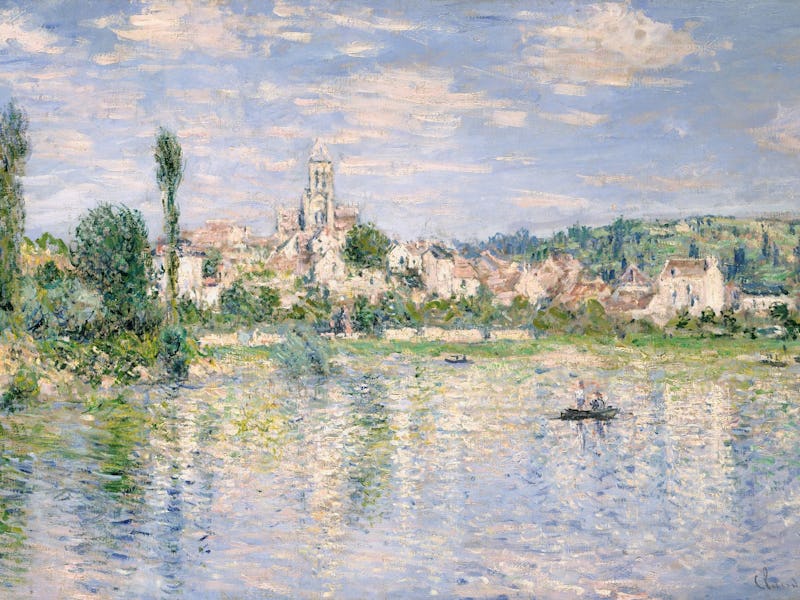Math uncovers hidden patterns in these historic art masterpieces
Art historians have missed something incredibly important lurking behind the canvases of art's greatest works.

Whether it's Michelangelo's Sistine Chapel ceiling, Andy Warhol's Campbell's soup cans, or ancient humans' lustrous cave paintings, the creation of art is an inherently human story.
Art historians have dedicated their lives to dissecting and discussing these influential works. But according to a new study published this week in the journal Proceedings of the National Academy of Sciences, scholars have missed something incredibly important lurking behind the canvases of some of the most celebrated masterpieces.
By applying a mathematical formula to nearly 15,000 works of art created across 500 years, a team of scientists has uncovered hidden patterns in these masterworks. In doing so, they not only change how we see this art, but also upend long-standing historic theories behind some of the world's most famous paintings.
Paint by numbers: Patterns in landscape paintings may reveal a "metanarrative" within the painting process, according to a new study.
Using math to understand something as fundamentally human as art may sound counter-intuitive, but artists themselves have actually been doing it for centuries. By applying ratios, including the so-called "golden ratio," artists have long sought to recreate absolute beauty using mathematical harmony. In this study, the researchers do something a little different: They used mathematical ratios to uncover a hidden "metanarrative" within the painting process.
"From individual qualitative work of art historians emerges a metanarrative that remains difficult to evaluate," write the authors.
Individual interpretation is a kind of qualitative analysis that has reigned supreme in art history. As a result, more subtle, or less easily perceived quantitative patterns have been overlooked, the researchers say. To get around that problem, they argue that a systematic, quantitative approach could be used alongside such qualitative analyses.
With any luck, this metanarrative could uncover previously ignored, or glossed over, anomalies in the world of art history.
See also: Meet Aican: The first automated artist to produce at $16,000 A.I. painting
Mathematical Masters — To build their mathematical framework, the researchers sourced digital scans of 14,912 landscape paintings spanning the Western renaissance to contemporary works.
This algorithm uses the difference between colored pixels to calculate information values and draw partitions.
With these paintings (digitally) in-hand, the researchers applied a mathematical algorithm that draws smaller and smaller partitions between areas with bigger differences between colors used. For example, the entire image would represent partition zero, and then partition number one would be drawn either horizontally or vertically between the two areas of the painting with the most color difference. While this operation could theoretically be done ad nauseam, the researchers chose to focus on partitions one and two.
They discovered that the overall composition of the landscapes, as determined by the direction of the partition, changed over time independently of the nationality of the artist.
"[T]he long-standing division of landscape art history by nation must be put into question, in favor of a broader comparative perspective," write the authors. "[And] library classification, metadata in visual resource collections, and the categorization of encyclopedia entries should follow suit."
They also uncovered instances when an individual artist's expression truly deviated from the overarching trends of the era. These iconoclasts may be overlooked in favor of a smoother, more "artificial," narrative of art history.
"[A] proper grand narrative of art history requires a multiplicity of perspectives, both qualitative and quantitative, as a great amount of nonlinear detail gets lost in an overly conventional mainstream narrative," the authors write in the study.
See also: One type of art can help you see the bigger picture in life – study
Room for improvement — While their samples did include a few works from Japanese and Chinese artists, the collection largely draws from the "canon of Western European art" — a shortcoming the researchers acknowledge and hope to broaden beyond in future studies.
In addition to the limited diversity of artworks used in this study, the authors write that the algorithm itself is also limited because it can only recognize partitions of straight lines and is not yet capable of handling something as seemingly mundane as a curve. The researchers hope their approach can be used as a fundamental background for future research that will expand on their initial techniques.
The technique could be used to investigate other forms of art as well, including photography, architecture, and typography.
Abstract: A foundational question in art and aesthetics is if there are culturally and temporally transcendent characteristics in the organizing principles within art and if yes, how these principles evolve over time. We propose a simple yet coherent information-theoretic framework that captures compositional proportion as used for dissecting landscape paintings by artists. The analysis of 14,912 landscape paintings representing the canonical historiography of Western art uncovers that the preferred compositional proportion within the historiography of landscape paintings systematically evolves overtime. The network analysis of similarity distributions reveals clear clustering structures of individual artist’s artworks, absolute time periods, and conventional style periods, suggesting meaningful supergroups of art historical concepts, which remained so far nonintuitive to a broader audience.